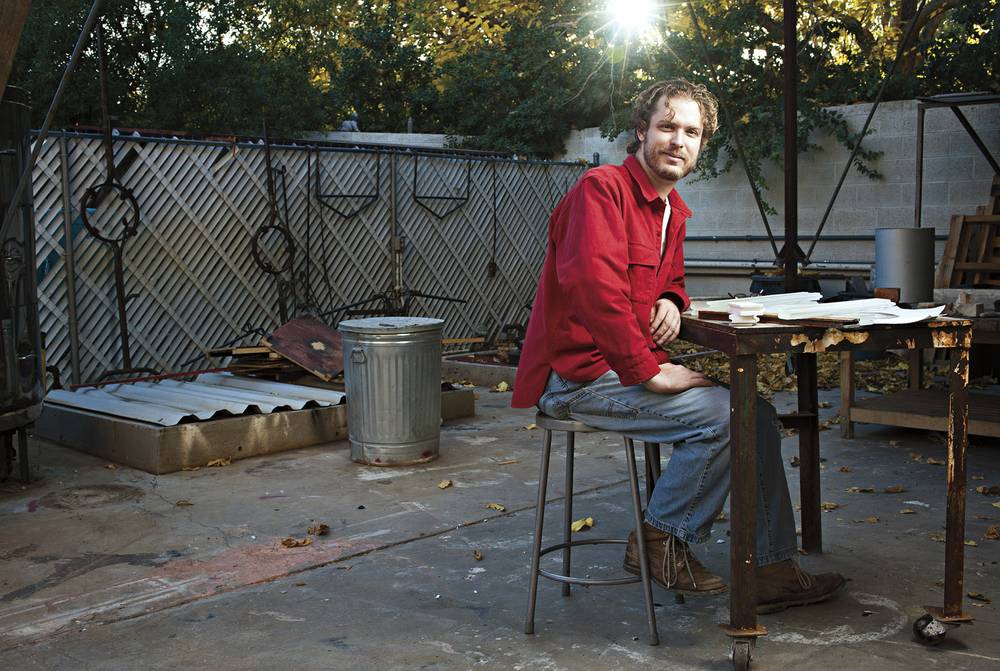Artist Brent Sommerhauser has had a career of making the familiar strange and the strange familiar. He once built an 8.5-by-11-foot, tongue-in-groove wood floor with its corner curled up like a sheet of paper lifting in the breeze. He sculpted a glass floor to reveal the normally invisible interlocking parts that bind wood floors together. And then he created a tornado from wood flooring to demonstrate different and unexpected behavior of the material.
Long before that, Sommerhauser was given permission to dissect a series of homes in Ohio set to be razed. He studied them, cut holes in the floors and walls, excavated doors and studied the many layers of paint in various colors left by tenants over the years. When someone referred to him as an “urban lobotomist,” it made sense on multiple levels.
He's shown locally at Michele C. Quinn Fine Art Advisory, Brett Wesley Gallery and Donna Beam Fine Art Gallery. Additionally, he’s one of five Las Vegas artists selected to help rehabilitate foreclosed homes in the Winchester neighborhood as part of the federal Neighborhood Stabilization Program. We talked with Sommerhauser about using homes as medium and subject.
When did homes become part of your work? It wasn’t until I went to graduate school. I had studied memory and the curve of learning and forgetting in psychology for my bachelor’s. Carl Jung told a story of the house as a stand-in for memory, and there is the mnemonic method of loci, which is used to remember things you file away in these different rooms constructed in your mind. And Emily Dickinson used the house as a metaphor for the psyche. I found that this was a great place to start working.
Did you begin with old homes? No. I’d build sections of houses to scale, like a wall. But it didn’t have the resonance. It wasn’t honest enough. Then I thought, “Somewhere they’re knocking down a house with a perfectly good wall.”
Did anyone question you as you scavenged materials from the old homes? It got really weird and complicated. There were homeless people. Scrappers. The FBI had permission to use the place for hostage crisis training. I had a guy threaten to kill me, then throw me in the hole I had just cut out.
Describe some of the experiences in the abandoned homes. There was a brick building that held three apartments. If I entered the middle one and shut the door, it got so quiet. I thought, “How can I bring that element into this?” I found paintings of the first grand pianos made so I could get the dimensions right. I cut that shape out of the floor so the room opened up to the basement and the whole space turned into a mute instrument. A lot of it was playing around. If I altered the environment, I’d always have to walk around something. I got to thinking, “What if the artwork was actually a hole in the floor and you could get hurt? Could it ever be ignored? Would you ever relax?”
What did your own home begin to look like? My apartment was full of other apartments. I’d have to navigate it all. I didn’t have any place to put 30 doors, so they all ended up in my hallway. Nobody came over anymore. It was like the Tom Waits song, “What’s he building in there?” The price of admission was what they thought I was doing in there, usually in the form of a drawing. I also soundproofed my apartment to see what it was like living in there. I tried to mimic things like the silence.
How did it culminate? Any work that came out of it was modest scale sculptures. A door was folded to create a space you couldn’t get into or verify. I cut a floor down to 8.5 by 11 inches, the size of a piece of paper. It was dog-eared in the way you would do to a book to remember your place in it.
Why did you start making the large wood floor sculptures? I wanted to make something that was stable and dependable so that I could highlight some sort of shift. And my grandmother had Alzheimer’s. I could imagine her sitting in her house alone with her dog and everything she knew was questionable. The floor lifting and pulling was a way to make that feeling visible.
Were there other pieces directly linked to that? I made a round table with the legs going inward that would spin and draw a circle. It lost its function as a table and became a table that could only describe itself. From the external, my grandmother looked like my grandmother, but by the behavior, she wasn’t the same confident person who could recognize me. Her ability to function as herself diminished, but she remained able to describe the person that she once was.








Previous Discussion: